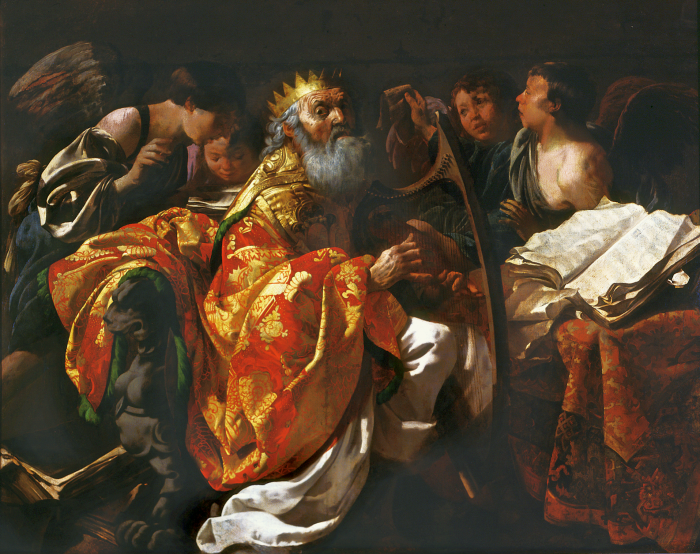
Lesson Objectives
- To understand the basic outline of Israel’s history in the centuries between the collapse of the Davidic kingdom and the beginning of the New Testament era.
- To appreciate how the collapse and disappearance of the Davidic Kingdom shaped Israel’s hopes and beliefs in the five centuries before Christ.
- To understand how God’s covenant promises were interpreted by Israel’s prophets and how those prophecies were understood in the last centuries before Christ.
I. The Kingdom That Did Not Come
A. Promise and Division
In our first lesson we looked at the origins of the Davidic covenant.
We saw how God’s promise to David, first delivered by an oracle of the prophet Nathan and later celebrated and meditated upon by the psalmists and prophets, marks the culmination of the salvation history told in the Old Testament.
The Davidic monarchy was the ultimate expression of Israel’s election as God’s chosen people. This election originated in the form of God’s covenant with the patriarch Abraham, father of the Israelite people. By this covenant God swore to make Abraham’s descendants a great nation, from whom kings would stem and through whom all nations would be blessed.
It was to fulfill His covenant promise to Abraham that God raised up Moses to lead Israel, the people born of Abraham’s seed, from captivity in Egypt. And it was to fulfill that covenant with Abraham that centuries later Israel’s King David was promised a divine dynasty - in which one of his heirs would reign over Israel for all time in a kingdom that would have dominion over all the nations and peoples of the world.
But historical events quickly overtook and called into question the meaning of God’s covenant with David. Within a generation after David’s death, the "everlasting kingdom" he was promised had vanished.
God’s promise seemed to have been clear - He would punish David’s sons should they prove unfaithful, but He would never withdraw His favor from David’s line (see 2 Samuel 7:5-15; 1 Kings 2:2-4: 8:25; 9:4-5; Psalm 132:12).
However, the abuses of David’s son, Solomon - who had been the immediate focus of Nathan’s promises - led to rebellion shortly after Solomon’s death in 930 B.C.
Ten of Israel’s twelve tribes, led by Jeroboam, split-off and established a Northern Kingdom, leaving Solomon’s son, Rehoboam, to reign over a Southern Kingdom consisting of the two tribes remaining in and around Jerusalem.
As depicted in Scripture, Jeroboam’s rebellion was God’s punishment for Solomon’s sin (see 1 Kings 11:31-39). The Northern tribes almost immediately went into apostasy, building altars and worshipping false gods (see 1 Kings 12:28-29). In 722 B.C., the Assyrians invaded the Northern Kingdom and hauled tens of thousands of Israelites into captivity. The Bible presents this as a punishment for their idolatry and sins against God’s covenant (see 2 Kings 17:7-18).
The Southern Kingdom, too, fell into corruption. In 586, King Nebuchadnezzar of Babylon crushed Jerusalem, destroyed the Temple and sent thousands off into exile (see 2 Kings 24-25; Jeremiah 52).
B. An Everlasting Throne Unseen
By the sixth century B.C., then, there was no Davidic Kingdom in sight.
This remained true even when Persia defeated Babylon in 538 B.C., paving the way for some Israelites to return to Jerusalem and begin rebuilding the Temple.
Throughout this "Second Temple" period and on into the last period recorded in the Old Testament - the period of the Maccabeean revolt and the Hasmonean dynasty circa 100-200 B.C. - we see little evidence that Israel hoped for any imminent return of the Davidic Kingdom.
The Maccabeean revolt was about covenant faithfulness - not the restoration of the Davidic Kingdom (see 1 Maccabees 1:15; 2:20, 49-68; 4:8-11).
Mattathias, one of the early heroes of the movement, affirmed his belief that "David, for his piety, received as a heritage a throne of everlasting royalty" (see 1 Maccabees 2:57).
But the revolt and the later Hasmonean dynasty did not invoke David.
The Hasmoneans were led by priests - not descendants of David. Yet the Israelites agreed to live under this form of priestly, theocratic rule "until a true prophet arises" (see 1 Maccabees 14:41). This was a reference to Moses’ ancient prophecy - that God would raise up a prophet like him (see Deuteronomy 18:15-19).
The Book of Sirach, written during this period, also affirms God’s promise to David, saying that God "exalted his strength forever….established his throne in Israel" (see Sirach 47:11). Sirach also affirmed that "God does not withdraw His mercy, nor permit even one of His promises to fail" (see Sirach 47:22).
Though we find no Davidic expectations in the latest Old Testament texts, such as Sirach and Maccabees, we know from the writings of the rabbis and others in the "intertestamental" period - the years between the writings of the Old and New Testaments - that there emerged a lively messianic hope based on God’s covenant with David and the promises of the prophets.
Other Lessons
- Lesson One: A Throne Established Forever
- To begin to appreciate the significance of God’s covenant with David for understanding the content and meaning of the New Testament.
- To understand the biblical idea of the monarchy and the Old Testament background for the Davidic covenant.
- To understand the basic outlines of the promises made to David and the shape of the Davidic kingdom under both David and Solomon.
- Lesson Three: The Son of David in Matthew’s Gospel
- To understand the symbolism Matthew uses to convey the truth that Jesus Christ is the perfect Son of David.
- To see how the baptism of Jesus corresponds to the anointing of the Davidic kings.
- To understand how Matthew sees Jesus’ kingdom as the fulfillment of the promises in the prophets.
- Lesson Four: The Throne of David, His Father
- To see how Luke emphasizes Jesus’ lineage as Son of David in the infancy narrative.
- To see how Jesus appears in public as the Son of David throughout Luke’s Gospel.
- To understand how, at the climax of Luke’s Gospel, Jesus takes his place as heir to the kingdom of David.
- Lesson Five: The Spread of the Kingdom in Acts
- To understand how Jesus’ parting words to His disciples form a map of the ideal Davidic kingdom.
- To see how the structure of the Acts of the Apostles follows that map.
- To see how Luke paints the nascent Church as the Davidic kingdom perfectly restored.
- Lesson Six: ‘The Key of David’: Church and Kingdom in the New Testament
- To understand the characteristics and identity of the kingdom of God as it is portrayed in the New Testament epistles and the Book of Revelation.
- To see how the Church is identified with the kingdom in the New Testament.
- To understand how the Church, as it is portrayed in the New Testament, bears the characteristics of the Davidic kingdom.

